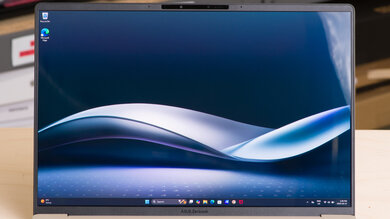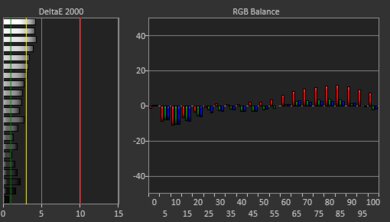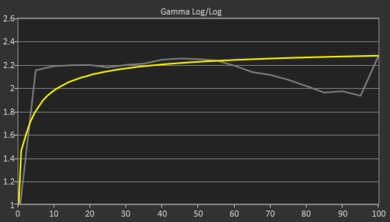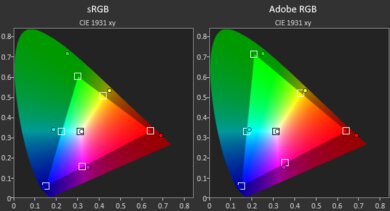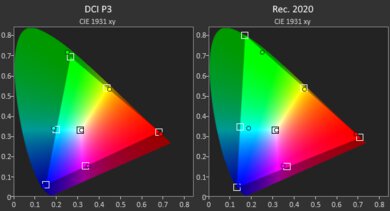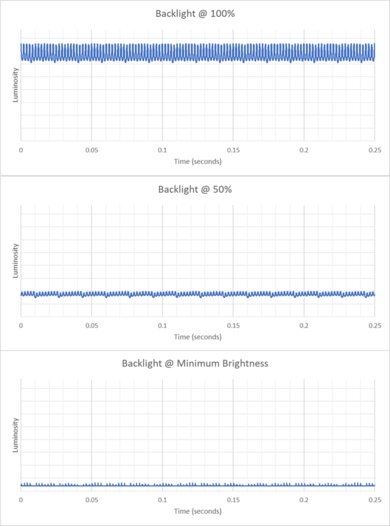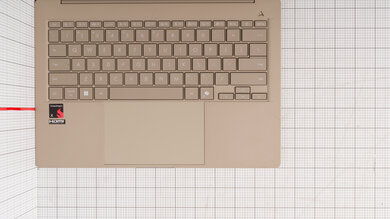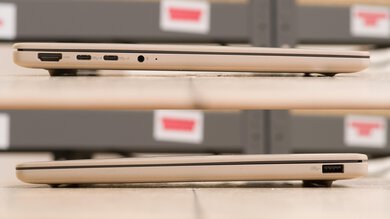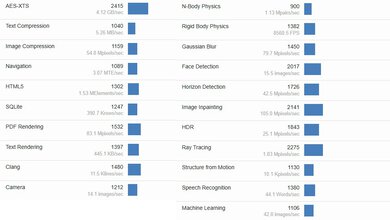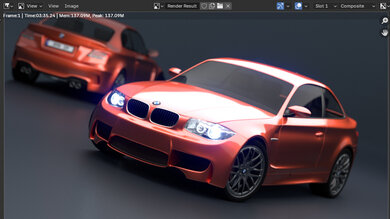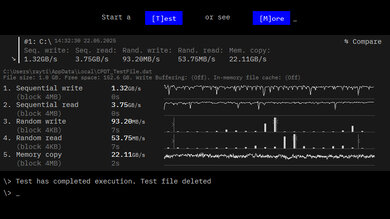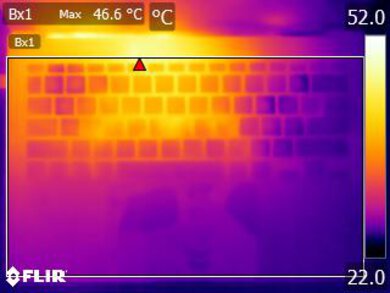The ASUS Zenbook A14 UX3407 (2025) is an ARM-based Windows ultraportable laptop. It's available with a Qualcomm Snapdragon X, X Plus, or X Elite SoC, with up to 32GB of RAM and 1TB of storage. It has a 60Hz FHD+ OLED display, a 1080p webcam with Windows Hello facial recognition, and Wi-Fi 6E or Wi-Fi 7 wireless connectivity. Ports include a 10Gbps USB-A, two USB-Cs (USB4), an HDMI 2.1, and a headphone jack.
See our unit's specifications and the available configuration options in the Differences Between Variants section.
Note: We performed the productivity benchmarks, gaming benchmarks, thermals and noise, and performance over time tests using the Best Performance mode instead of the default Balanced mode. This change makes the results more representative of the laptop's maximum potential and brings them closer to user expectations. However, this also means that the results are only comparable with reviews containing this disclaimer, as we previously tested laptops in their default mode, which usually throttles performance to prolong battery life.
Our Verdict
The ASUS Zenbook A14 is excellent for school use. Its compact design makes it easy to carry around, and its battery life is exceptional, lasting around 19 hours in light uses. The overall user experience is great; it has a nice OLED display, a comfortable keyboard, and a large, responsive touchpad. The Snapdragon SoCs can handle most student workloads like text processing and web browsing, as well as more demanding tasks like programming if you get a model with the top-end X Elite chip. However, their weak integrated GPUs aren't ideal for graphically intensive tasks like 3D graphics. Also, app compatibility might be an issue, as most specialized programs lack support for Windows on ARM, so you need to ensure that the apps you use can run with minimal issues.
-
Thin and light design.
-
Exceptional battery life.
-
Comfortable keyboard, large touchpad.
-
Decent 1080p webcam.
-
Great port selection.
-
Snapdragon SoC can't handle demanding tasks.
-
Some apps might not work or perform poorly through emulation.
-
Display's glossy finish doesn't handle reflections well.
The ASUS Zenbook A14 isn't designed for gaming. Its Snapdragon SoC can't handle demanding AAA games, and most games lack support for Windows on ARM, so some might not run at all or perform poorly through emulation. Also, while its OLED display has a fast response time, it's limited to a 60Hz refresh rate with no VRR support to reduce screen tearing.
-
User-replaceable storage drive.
-
Snapdragon SoC can't handle demanding tasks.
-
Some apps might not work or perform poorly through emulation.
-
60Hz display.
-
No VRR support.
The ASUS Zenbook A14 is decent for media consumption. This compact, easy-to-carry laptop has an exceptional battery life, giving you plenty of time to binge-watch movies and TV show episodes. Its FHD+ display looks sharp, and like all OLEDs, it produces deep, inky blacks for a better dark room and HDR viewing experience. A downside of the display is that its glossy finish doesn't handle reflections all that well, so visibility can be an issue in well-lit settings. Unfortunately, while the speakers get reasonably loud, they sound unnatural and boxy, with very little bass.
-
Thin and light design.
-
Exceptional battery life.
-
Colorful OLED display.
-
Speakers sound unnatural and boxy, with very little bass.
-
Display's glossy finish doesn't handle reflections well.
The ASUS Zenbook A14 isn't designed for use as a workstation, as its Qualcomm Snapdragon SoC can't handle highly intensive tasks. Plus, you can only get up to 32GB of soldered RAM, and many professional applications lack support for Windows on ARM. You can do some color-critical work like photo and video editing (provided that the applications are compatible), as its OLED panel has full sRGB and DCI P3 coverage, as well as near-full coverage of the Adobe RGB color space.
-
Great port selection.
-
User-replaceable storage drive.
-
Display is suitable for some color-correction work.
-
Snapdragon SoC can't handle demanding tasks.
-
Some apps might not work or perform poorly through emulation.
-
Can only get up to 32GB of soldered RAM.
The ASUS Zenbook A14 is great for business use. This compact 14-inch model feels well built, and its battery lasts around 19 hours in light uses, making it an amazing choice for those who travel a lot for work. It has a nice OLED display, a comfortable keyboard, a large touchpad, and a decent 1080p webcam. You get a facial recognition camera for quick logins, which is great if you want to avoid typing in your password in public areas. Its Snapdragon SoC can easily handle general productivity tasks like text processing, spreadsheets, presentations, and video playback. However, since it's an ARM processor, you must ensure that the apps you use have a native ARM version or run well enough through emulation to get your work done.
-
Thin and light design.
-
Exceptional battery life.
-
Comfortable keyboard, large touchpad.
-
Decent 1080p webcam.
-
Great port selection.
-
Some apps might not work or perform poorly through emulation.
-
Display's glossy finish doesn't handle reflections well.
- 8.6 School
- 5.5 Gaming
- 7.4 Multimedia
- 7.9 Workstation
- 8.0 Business
Changelog
- Updated Jun 09, 2025: Review published.
- Updated Jun 03, 2025: Early access published.
- Updated Apr 07, 2025: Our testers have started testing this product.
- Updated Mar 25, 2025: The product has arrived in our lab, and our testers will start evaluating it soon.
- Updated Mar 05, 2025: We've purchased the product and are waiting for it to arrive in our lab.
Differences Between Sizes And Variants
We tested the ASUS Zenbook A14 UX3407 with a Qualcomm Snapdragon X X1 26 100 SoC, 16GB of RAM, and 512GB of storage. The SoC, memory, and storage are configurable; the available options are below.
SCREEN
- 14" OLED 1920 x 1200 60Hz (glossy, 100% DCI P3)
SoC
- Qualcomm Snapdragon X X1 26 100 (8 cores/8 threads, up to 2.98GHz, Adreno X1-45 iGPU, 30MB cache)
- Qualcomm Snapdragon X Plus X1P 42 100 (8 cores/8 threads, up to 3.2GHz, Adreno X1-45 iGPU, 30MB cache)
- Qualcomm Snapdragon X Elite X1E 78 100 (12 cores/12 threads, up to 3.4GHz, Adreno X1-85 iGPU, 42MB cache)
MEMORY
- 16GB LP-DDR5x 8448MHz
- 32GB LP-DDR5x 8448MHz
STORAGE
- 512GB M.2 2280 PCIe Gen 4 NVMe SSD
- 1TB M.2 2280 PCIe Gen 4 NVMe SSD
COLOR
- Iceland Gray
- Zabriskie Beige
Compared To Other Laptops
The ASUS Zenbook A14 is a great ultraportable laptop. Its battery life is among the best compared to other ultraportables, even against the likes of the Apple MacBook Air 13 (M4, 2025) and the Microsoft Surface Laptop 7th Edition 15 (2024). While its FHD+ display and diving board touchpad are adequate, they're somewhat disappointing, as many laptops in its class have a higher resolution screen and a haptic touchpad. As for performance, the Qualcomm Snapdragon SoCs are capable, but app compatibility is still an issue, as many programs still lack support for Windows on ARM.
For more options, check out the best ultrabooks, the best lightweight laptops, and the best laptops for battery life.
Choosing between the ASUS Zenbook A14 UX3407 (2025) and the ASUS Zenbook 14 OLED (2024) depends on what you care about most. The Zenbook 14 OLED provides a better user experience overall; it has a sturdier all-aluminum build, higher-resolution 120Hz display options, and a much better webcam. While its Intel Meteor Lake CPU performs slightly better than the Zenbook A14's ARM-based Snapdragon SoC, the latter is much more power-efficient, resulting in significantly longer battery life on the Zenbook A14. That said, the Zenbook 14 OLED is better when it comes to app compatibility. This is because most programs lack support for Windows on ARM, so if you're considering the A14, just make sure you check that the apps you use are compatible or run well enough through emulation.
The ASUS Zenbook A14 UX3407 (2025) and the Apple MacBook Air 13 (M4, 2025) are both ultraportable laptops designed for general productivity. The Zenbook A14 has a much better battery life, but the MacBook Air is otherwise a better laptop overall, providing a more premium user experience with its brighter, sharper display, easier-to-use haptic touchpad, superior webcam, and fuller sounding speakers. Performance-wise, the MacBook Air's M4 SoC has much better single-thread performance than the Zenbook A14's Qualcomm SoC, making the system feel snappier and more responsive.
The ASUS Zenbook A14 UX3407 (2025) and the Lenovo Yoga Slim 7i Aura Edition 15 (2024) are both great ultraportables. In terms of user experience, the Yoga Slim 7i comes out ahead; it has a sturdier build, a sharper, brighter screen, and a more comfortable keyboard with longer travel keys. However, the Zenbook A14 is more portable, and its battery life is in a league of its own, lasting almost eight hours longer than the Yoga Slim 7i. One thing to keep in mind about the Zenbook A14 is that it's an ARM-based model using a Qualcomm Snapdragon SoC. This means some apps might not work or will run poorly, so make sure the apps you use work first.
The ASUS Zenbook A14 UX3407 (2025) and the Microsoft Surface Laptop 7th Edition 15 (2024) are both ARM-based Windows ultraportables. The Surface Laptop is a more premium device that provides a better user experience overall, sporting a brighter, higher-resolution display, a more comfortable keyboard, an easier-to-use haptic touchpad, and a much better webcam. If you want touch input, know that only the Surface Laptop supports it. The Zenbook A14 comes out ahead in battery life, though both laptops will get you easily through a typical day with little trouble.
Test Results
The ASUS Zenbook A14 is available in an Iceland Gray or Zabriskie Beige colorway. See the bottom of the laptop.
The ASUS Zenbook A14's build quality is good. Dubbed 'Ceraluminum', the chassis' material is an alloy made of ceramic and aluminum. The body feels relatively sturdy—there's a fair amount of flex on the keyboard deck, but only a little bit on the lid. An element in the construction that could be better is the display's hinge. It isn't so much a build quality issue, but the hinge's resistance could be tighter, as it would prevent the screen from moving when picking up the laptop. The finish has a soft matte feel that's similar to some mice (think Razer DeathAdder V3 Pro), albeit more metallic and premium. It doesn't pick up many fingerprints or smudges; minor scratches appear with regular use, but a quick wipe with a microfiber cloth buffs them away almost completely. The feet feel solid and stick firmly to the bottom.
Our unit's display is slightly warped, which you can see in the reflections photo; however, the warping is so minor that it's unlikely to be an issue in terms of durability.
The hinge operates smoothly when opening and closing the lid. As mentioned in the Build Quality section above, its resistance is on the looser side, which makes the laptop easier to open with one hand but causes the screen to move when picking up the laptop. Heavy typing doesn't make the screen wobble, though.
Accessing the ASUS Zenbook A14's internals is very easy; you only need to remove 10 screws and release the bottom panel's clips. A prying tool isn't necessary, but might help. The screws are of two different sizes, so it's best to keep them organized to facilitate the reassembly. The storage slot supports M.2 2280 PCIe Gen 4 NVMe SSDs.
Download the service manual here.
The ASUS Zenbook A14 is only available with an FHD+ OLED display. The FHD+ resolution looks pretty sharp on a 14-inch screen—you can see individual pixels up close, but this isn't a problem at typical viewing distances. A 16:10 aspect ratio is great for productivity, as it gives you more vertical space than a standard 16:9 screen, allowing you to see more information at once when reading a document or website. OLEDs are susceptible to permanent burn-in, but it's unlikely to be an issue if you take active measures to prevent it, like hiding Windows' taskbar.
You can only get this laptop with a 60Hz display, which is fairly typical when it comes to productivity laptops. A higher refresh rate improves motion smoothness and input responsiveness, but it won't matter much if you mainly look at static content like documents and spreadsheets. This panel's response time is excellent, resulting in only a tiny amount of ghosting behind fast-moving objects.
The display gets bright enough for use in most indoor settings but not outdoors in broad daylight. Visibility can be an issue, even indoors, as the display's glossy finish struggles with bright light sources like lamps. ASUS advertises a maximum brightness of 600 cd/m² in HDR; we could only achieve 534 cd/m², and that's only in scenes with small highlights.
The display's glossy finish doesn't handle reflections all that well, struggling especially with bright light sources like lamps and open windows during the day. These reflections are visible even with the screen at full brightness.
The display's out-of-the-box accuracy is okay. Overall, the white balance is very good; the inaccuracies are mostly at higher brightness levels where there's too much red. As for color accuracy, the color dE is high, mainly because the panel uses a wider color space by default, resulting in oversaturation. Unfortunately, the gamma doesn't follow the curve at all, making dark scenes too dark and bright scenes too bright.
The display's color gamut is superb. It has full coverage of the sRGB and DCI P3 color spaces, as well as near-full coverage of the Adobe RGB color space. This panel is suitable for general media consumption and color-critical work like photo and video editing.
The ASUS Zenbook A14 has a great keyboard. Its layout feels spacious and is easy to get used to. The keys could use slightly more travel and tactility, but this is otherwise a comfortable keyboard to type on for long periods. There's some padding to provide a more cushioned feel when bottoming out, which helps reduce the harshness you would typically feel on keyboards with short travel. There are three backlight brightness levels; the backlight shines well and evenly through the legends.
The ASUS Zenbook A14 has a large, smooth touchpad that tracks all movements and gestures well. Palm rejection works as intended, and there are no issues with actions like dragging and dropping items. Swiping at the edges of the touchpad lets you quickly access some system settings, like changing the screen brightness and audio volume level—you can disable this feature in the MyASUS app. This is a diving board touchpad with mechanical buttons. You can perform clicks pretty far up (almost three-quarters of the way up); it just takes more effort the higher you go. The actuation feels reasonably tactile—not super clicky but not mushy either.
The ASUS Zenbook A14's bottom-firing speakers get reasonably loud with only a small amount of compression at higher volume levels. Unfortunately, they sound unnatural, boxy, and hollow, with very little bass.
The webcam is decent. The image is a little soft, with a small amount of noise here and there, but you can still see some fine details. There's a slight greenish tint, and the color temperature is on the warmer side. Voices sound clear, though there's some static noise in the background.
The ASUS Zenbook A14 has a great port selection. The USB-A port supports USB Gen 3.2 Gen 2 data transfer speed of up to 10Gbps. Both USB-Cs support USB4 data transfer speed (up to 40Gbps), DisplayPort 1.4, and Power Delivery. ASUS advertises the HDMI port as an HDMI 2.1 TMDS (Transition-Minimized Differential Signaling), which has a resolution output limit of 4k @ 60Hz; however, we can confirm that the port can output a 4k @ 120Hz signal.
The ASUS Zenbook A14 uses the Qualcomm QCNFA725A Wi-Fi 6E wireless adapter. Models with a Snapdragon X Elite X1E 78 100 SoC have a Wi-Fi 7 wireless adapter. Wi-Fi 6E and Wi-Fi 7 have faster speeds, lower latency, and less signal interference than previous Wi-Fi standards. However, you need a Wi-Fi 6E or Wi-Fi 7 router to benefit from these features. Check out our best router recommendations if you want to upgrade your home wireless network.
The ASUS Zenbook A14 is available with the following SoCs:
- Qualcomm Snapdragon X X1 26 100 (8 cores/8 threads, up to 2.98GHz, Adreno X1-45 iGPU, 30MB cache)
- Qualcomm Snapdragon X Plus X1P 42 100 (8 cores/8 threads, up to 3.2GHz, Adreno X1-45 iGPU, 30MB cache)
- Qualcomm Snapdragon X Elite X1E 78 100 (12 cores/12 threads, up to 3.4GHz, Adreno X1-85 iGPU, 42MB cache)
All three are ARM-based SoCs (System-on-Chip) using Qualcomm's Oryon cores. Qualcomm has three tiers of SoCs: Snapdragon X Elite, Snapdragon X Plus, and Snapdragon X, with the latter being the lowest tier. These are power-efficient chips designed for general productivity, like text processing, spreadsheets, web browsing, and video playback. The top-end Snapdragon X Elite chip can handle fairly demanding multi-threaded workloads, but as we've seen with other ARM-based laptops with these Snapdragon processors, hardware isn't really the problem; it's software compatibility, since many programs don't run natively on an ARM-based system. This means some apps, especially professional third-party apps, might not work or will run poorly through emulation. Compatibility will likely improve over time, but for now, just check that the apps you use run properly. All three SoCs have the same NPU (Neural Processing Unit) with a rated performance of 45 TOPS (Trillions of Operations per Second) to handle AI tasks.
See more information about the Snapdragon SoCs in Qualcomm's product brief.
The ASUS Zenbook A14 is only available with an integrated GPU. The Snapdragon X X1 26 100 and Snapdragon X Plus X1P 42 100 have the same Adreno X1-45 iGPU, while the Snapdragon X Elite X1E 78 100 has the Adreno X1-85 iGPU. These iGPUs are primarily designed for light productivity tasks, so don't expect to do anything intensive, like 3D graphics or gaming. The X1-85 is faster than the X1-45, but the difference isn't big enough to make much difference in practice.
You can get this laptop with 16GB or 32GB of RAM. The memory isn't user-replaceable.
You can get this laptop with 512GB or 1TB of storage. The storage is user-replaceable—the slot supports M.2 2280 PCIe Gen 4 NVMe SSDs.
The ASUS Zenbook A14 scores fairly well in the Geekbench 5 benchmarks. The Snapdragon X X1 26 100's single-thread performance is a little low compared to current-gen competing processors from the likes of AMD, Intel, and Apple, but its multi-thread performance is pretty good, scoring in the same ballpark as Intel's Lunar Lake SoCs. This performance is suitable for common, everyday productivity tasks. The Snapdragon X Plus X1P 42 100 is only slightly faster overall, while the Snapdragon X Elite X1E 78 100 is significantly faster, especially in multi-threaded workloads. The GPU compute test doesn't run in Geekbench 5, but as mentioned in the GPU section, the integrated GPU is pretty weak and isn't suitable for intensive tasks. It runs in Geekbench 6, though; here are all three results:
Geekbench 6
- Single-Thread: 1599
- Multi-Thread: 8042
- GPU Compute: 7408
Cinebench R23 doesn't run properly on ARM-based systems, resulting in unusually low numbers, so we've performed additional benchmarks in Cinebench 2024, which has a native ARM version. Here are the results:
- Single-thread (Best Performance): 72
- Multi-thread (Best Performance): 541
The Snapdragon X X1 26 100's performance is only suitable for light and some moderately intensive tasks. Compared to the Apple MacBook Air 13 (M4, 2025)'s base M4 SoC, its single-thread performance is 58% slower, while its multi-thread performance is 25% behind. The Snapdragon X Elite X1E 78 100 is the best option if you need to run heavier multi-threaded applications. For highly intensive workloads, you're better off getting a gaming or workstation laptop.
The Snapdragon X's Adreno GPU is an integrated graphics processor designed for light productivity tasks, so don't expect to play any graphically intensive games. You can play some simple, puzzle-like games or older titles, but you'll have to play at a lower resolution or with low graphics settings to get playable frame rates. Also, since most games don't run natively on an ARM processor, the performance will vary significantly from one game to another, depending on how well the Prism emulation layer works for a particular game.
Models with the Snapdragon X Elite X1E 78 100 SoC will likely have a shorter battery life.
Borderlands 3 isn't playable on the ASUS Zenbook A14. The Snapdragon SoC's integrated graphics aren't powerful enough to handle this and other similarly demanding titles. Also, the game doesn't run natively on an ARM-based processor, so there's likely some performance loss from running it through Microsoft's Prism translation layer. The Snapdragon X Elite's iGPU will fare better, but not enough to make the game playable.
Civilization VI runs terribly at 1080p. You can get over 30 fps with low graphical settings, which is enough for a strategy game such as this, but the gameplay is still choppy, and the average turn time is very long.
Counter-Strike 2 isn't playable at 1080p. The gameplay is extremely choppy, even with low graphical settings.
Shadow of the Tomb Raider runs poorly on the ASUS Zenbook A14. The gameplay is too choppy due to frame drops, even with low graphical settings.
The keyboard deck gets quite warm under load, but the hot spot is near the top of the deck, away from where most people rest their hands. The bottom of the laptop reaches 43.5 °C (110.3 °F), which is warm but not enough to cause discomfort when using the device on your lap.
The fans are fairly loud at full speed. You can change the fan profile via the MyASUS app, albeit at the cost of some performance loss.
We can't test the performance over time because the software we use to perform the test isn't compatible with Windows on ARM. That said, there's likely some thermal throttling, which is typical for most thin and light laptops.
The ASUS Zenbook A14 has a few pre-installed applications; see this video for the full list.
The ASUS Zenbook A14 has a Windows Hello facial recognition IR camera. You can use it to log in quickly, authorize purchases in the Windows Store, and auto-fill saved passwords on supported websites.








